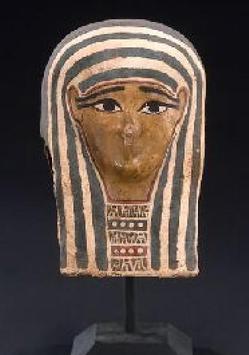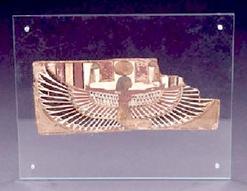Cartonnage
Cartonnage is the term for layers of fibers, most often linen and papyrus, mixed with a plaster that could be shaped or molded while wet, almost like a papier-mache process that uses whole sections of fibers rather than the pulped or shredded paper used with papier-mache. In ancient Egypt, this technique was used in the funerary process to create masks, paneled sections or even complete cases to cover the body, which would have been mummified and wrapped before this application. After the plaster surface dried and hardened, it offered artists a smooth, fresh surface for their delicate painted decorations.

A cartonnage mummy mask from the Ptolemaic Period. (p4A item # A076668)
Since cartonnage was often produced with large sections of papyrus, it has become an important source of early Egyptian documents; recycled documents were often put to use, and modern experts frequently separate some of the layers in order to study the writings, finding everything from government documents to literary fragments. This is, of course, a controversial issue, as the separation inevitably destroys the original cartonnage object or fragment.

A cartonnage fragment depicting the Goddess Nut, from the Ptolemaic Period. (p4A item # A054540)
Hollie Davis, Senior p4A Editor, July 10, 2009
